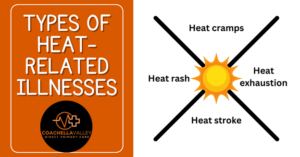Heat can be a real beast, can’t it? I remember a time when I thought I was invincible in the face of the sun‘s scorching rays. Boy, was I wrong! Heat illness is no joke. It can sneak up on you like a thief in the night, leaving you feeling miserable and downright dangerous.
I’m here to arm you with the knowledge you need to conquer the summer sizzle and steer clear of heat illness. These techniques have been put through the wringer and come out on top, so you can trust they’ll keep you feeling great.
Why don’t you grab an icy beverage and join me under a tree? We’re going to talk about staying safe in the heat, and your body will be grateful for the knowledge.
Coachella Valley Direct Primary Care
Frustration-free health care for the whole family. A monthly membership program designed for the busy Coachella Valley family to give you direct access to primary healthcare services so you can be healthy and active. Schedule a free consultation. 760-642-5549
Table Of Contents:
- Understanding Heat-Related Illnesses
- The Dangers of Extreme Heat
- Preventing Heat-Related Illnesses
- Recognizing Symptoms of Heat Exhaustion and Stroke
- First Aid for Heat-Related Conditions
- Populations at Greater Risk for Heat Illnesses
- Tips for Staying Cool During a Heat Wave
- Adapting Outdoor Activities in Hot Weather
- Emergency Response to Severe Heat Illness
- Conclusion
Understanding Heat-Related Illnesses
Heat-related illnesses are no joke. They can range from mild symptoms like heat rash to life-threatening conditions like heat stroke. It’s important to understand the spectrum of heat-related health problems so you can recognize the signs and take action before things escalate.

Types of Heat-Related Illnesses
There are several types of heat-related illnesses to be aware of:
- Heat cramps: Painful muscle spasms, usually in the legs or abdomen, caused by heavy sweating and loss of electrolytes.
- Heat exhaustion: A condition marked by heavy sweating, rapid pulse, dizziness, fatigue, cool skin with goosebumps, and sometimes muscle cramps.
- Heat stroke: The most severe form of heat illness, characterized by a high body temperature (above 103°F), hot and dry skin, rapid and strong pulse, and possible unconsciousness. This is a medical emergency.
- Heat rash: A skin irritation caused by excessive sweating, appearing as a red cluster of pimples or small blisters.
It’s crucial to recognize that heat illness can quickly escalate into a life-threatening condition without proper prevention and swift action.
The Dangers of Extreme Heat
Extreme heat is no joke. When temperatures soar, so does the risk of heat-induced illness. Hot environments, whether outdoors under the blazing sun or indoors without proper ventilation, can take a serious toll on your body. The thing is, our bodies work hard to maintain a normal temperature. But when exposed to extreme heat, that natural cooling system can get overwhelmed. Cue the heat-related health problems.
Studies show that heat illness is more common during the hottest times of the year and in sweltering environments. No surprise there, right? But here’s the kicker: It doesn’t take an official heat wave for heat to wreak havoc on your health. Even seemingly mild temperatures can be dangerous if humidity is high or you’re not used to the heat.
Preventing Heat-Related Illnesses
An ounce of prevention is worth a pound of cure, especially when it comes to heat-related illnesses. Trust me, you don’t want to find yourself in the throes of heat exhaustion or worse. The good news? There are plenty of strategies and tips for avoiding the onset of symptoms associated with excessive heat exposure.
Hydration and Nutrition
First and foremost, hydration is key. When you’re sweating buckets, your body is losing vital fluids and electrolytes. You need to replenish them, stat. Drink plenty of water, even if you’re not thirsty. And don’t forget about electrolytes – they’re the unsung heroes of hydration. Sports drinks can help maintain that delicate balance.
Dressing for the Weather
What you wear matters too. Opt for loose, lightweight, light-colored clothing. It helps your skin breathe and reflects heat instead of absorbing it. Don’t skimp on the accessories either. A wide-brimmed hat and sunglasses offer much-needed protection from the sun’s harsh rays. The key is to stay cool, both literally and figuratively. Recognizing the early signs and symptoms of heat illness can prevent it from progressing to the danger zone of heat stroke.
Recognizing Symptoms of Heat Exhaustion and Stroke
Knowing the warning signs of heat exhaustion and heat stroke can be the difference between a close call and a medical emergency. Pay attention to your body temperature. If it’s rising into the danger zone (above 103°F), that’s a red flag. Another telltale sign? A change in mental status. Confusion, agitation, slurred speech, or loss of consciousness are all indicators that heat stroke may be setting in. The tricky part is that the boundary between heat exhaustion and heat stroke isn’t always clear-cut. It’s a spectrum, and symptoms can worsen quickly.
First Aid for Heat-Related Conditions
If you suspect someone is suffering from a heat-related illness, swift action is crucial. Every minute counts. First, get them to a cool area, whether that’s an air-conditioned room or a shady spot outside. Loosen or remove any heavy clothing. If they’re conscious, give them cool water to drink. Not ice-cold, though – that can cause stomach cramps. If they’re not alert or can’t drink, don’t force it.
You can also try cooling measures like spraying them with cool water, applying ice packs to the armpits and groin, or fanning them. Remember, heat exhaustion is no joke. It’s a life-threatening rise in body temperature caused by heat stress and dehydration. When in doubt, call 911.
Populations at Greater Risk for Heat Illnesses
While anyone can fall victim to heat-related illnesses, some groups are more vulnerable than others. It’s important to understand who’s at greater risk and why.
Chronic Conditions and Medication Factors
Certain health issues can make you more susceptible to the effects of high temperatures. Heart disease, for example, makes it harder for your body to pump blood and regulate temperature. High blood pressure and some medications, like diuretics (water pills), can also increase your risk by affecting your body’s ability to stay hydrated and cool. Age plays a role too. Older people and young children are particularly vulnerable due to less efficient temperature regulation systems.
Tips for Staying Cool During a Heat Wave

When a heat wave hits, it’s not just about comfort – it’s about survival. Here are some practical tips for managing through periods of unusually high temperatures:
Utilizing Public Cooling Centers
Many communities designate cool spaces like libraries, shopping malls, or recreation centers as public cooling centers during heat waves. These air-conditioned havens can provide much-needed relief, especially if you don’t have AC at home. Don’t tough it out in a sweltering apartment – seek out these cool spaces and give your body a break. Even if you can’t spend the whole day there, a few hours in a cool, shady area can make a world of difference.
Adapting Outdoor Activities in Hot Weather
I get it – you don’t want to be cooped up inside all summer. But when the mercury rises, you need to be smart about outdoor activities.
Safe Exercise Practices
If you’re going to exercise outdoors, do it safely. Avoid the hottest parts of the day, typically between 11 a.m. and 4 p.m. Opt for the cooler morning or evening hours instead. And take it slow – this isn’t the time to push your limits. Start gradually and pace yourself. If you’re not used to working out in the heat, don’t expect to perform at your usual level right away. It takes time for your body to acclimate. And of course, stay hydrated. Drink water before, during, and after your workout, even if you’re not thirsty.
Emergency Response to Severe Heat Illness
In severe cases of heat illness, every second counts. If you see someone experiencing symptoms like high body temperature, confusion, loss of consciousness, or hot, dry skin, call 911 immediately. While waiting for help to arrive, move the person to a cooler area and try to bring down their body temperature with cool cloths or a cool bath. If they’re awake and able to drink, offer them cool water or a sports drink with electrolytes. But if they’re unconscious or unable to drink, don’t force it.
Remember, heat stroke is a medical emergency. It can cause damage to the brain and other vital organs, or even death if not treated promptly. Don’t take chances – err on the side of caution and seek medical help right away.
Key Takeaway:
Beat the heat by staying hydrated, dressing smart, and knowing the signs of heat illness. Don’t push your limits in high temps. Help’s a call away if things get serious.
Conclusion
Preventing and treating heat illness is all about listening to your body and taking proactive steps to stay cool. Drink plenty of fluids, dress appropriately, and take breaks in the shade when you need to.
Listen up, folks! Heat exhaustion and heat stroke are no joke. If you or a loved one starts feeling off in the heat, don’t wait around – get medical help pronto. It’s always better to play it safe than sorry in these situations.
So, the next time the mercury rises, you’ll be armed with the knowledge and tools to beat the heat. Stay cool, stay hydrated, and most importantly, stay safe out there!

